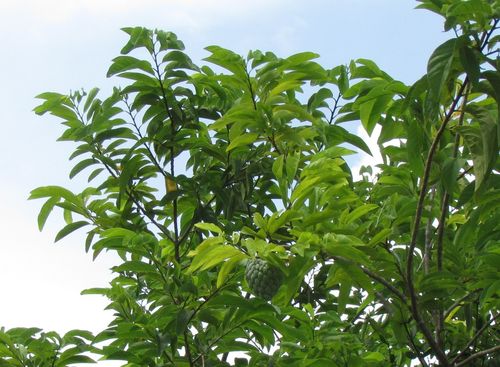Botanical name: Annona squamosa | Hindi: सीताफळ| Marathi: सीताफळ

About
Sitafal, scientifically known as Annona squamosa, is a tropical evergreen tree celebrated for its delectable and custard-like fruit. Native to the American tropics, this small to medium-sized tree thrives in warm climates. Characterized by glossy, oblong leaves and distinctive greenish-yellow flowers, Sitafal yields a spherical or heart-shaped fruit with a scaly exterior. The sweet, white pulp inside contains black seeds and is a culinary delight. Renowned for its rich nutritional profile, Sitafal is not only cherished for its delicious taste but also valued for its potential health benefits. The tree exemplifies the botanical diversity and culinary significance of tropical regions.
Interesting Facts

Medicinal Uses: Sitafal, or Annona squamosa, extends beyond its culinary appeal to offer medicinal benefits. The fruit is a rich source of vitamins, particularly vitamin C, promoting immune health. Its seeds and leaves are harnessed in traditional medicine for their antispasmodic and diuretic properties, addressing ailments like dysentery. Sitafal extracts exhibit antioxidant potential, combating oxidative stress. Compounds found in the fruit are studied for their anti-inflammatory and anti-cancer properties. Additionally, the plant is explored for its hypoglycemic effects, suggesting a role in diabetes management. With a blend of nutrients and bioactive compounds, Sitafal embodies a holistic approach to well-being in traditional medicinal practices.

Food & Culinary usage : Sitafal, scientifically known as Annona squamosa, graces culinary landscapes with its sweet and creamy fruit. Also referred to as custard apple, its luscious white pulp, punctuated by dark seeds, becomes a gastronomic delight. Eaten fresh or blended into smoothies and desserts, Sitafal imparts a unique tropical flavor. The fruit’s versatility extends to jams, ice creams, and beverages, showcasing its popularity in diverse culinary creations. Renowned for its natural sweetness and nutritional richness, Sitafal not only tantalizes taste buds but also contributes to a variety of delectable dishes, making it a cherished ingredient in regional and international cuisines..

Environmental Impact: While Sitafal (Annona squamosa) primarily serves as a delectable fruit, it also brings ecological benefits to the environment. The tree, being evergreen, provides consistent green cover, contributing to biodiversity and serving as a habitat for various bird species. Its deep root system aids in preventing soil erosion and stabilizing the soil structure. Additionally, the fallen leaves of the Sitafal tree decompose, enriching the soil with organic matter and supporting microorganisms. As a fruit-bearing tree, Sitafal can attract pollinators, fostering a healthier ecosystem. Its role in agroforestry practices further underscores its potential to promote sustainable land use and environmental well-being.
Anandvan Trivia Quiz
Question 1: Which village in Pune district is famous for growing me?
Answer: Pimpari Dumala in Pune district is famous for growing Sitafal
